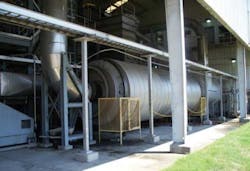Getting the Déjà Vu Out of England's Droughts
Drought conditions in England have forced utilities to enforce a hosepipe ban and look for additional water supplies. Is a pipeline transferring water from the north of the country to the south one answer? How would the cost compare to increasing the country's limited desalination capacity? Dr David Lloyd Owen reports.
Long run marginal cost estimates for resources, treatment & bulk transport
Earlier this year, we were warned that unless there was heavy rainfall in March, drought orders were looming for south and east England. Instead of a rainy let-off, we got the fifth driest March since 1910, and as the snows and rain descended from the north, 'temporary use bans' took effect for customers of Southern Water, South East Water, Thames Water, Anglian Water, Sutton and East Surrey, Veolia Central (Three Valleys) and Veolia South East (Folkestone & Dover).
Over 20 million people will be affected by these restrictions, until at least the autumn. Standpipes have not been ruled out later on in the year. Are we entering an era of chronic water scarcity or can we secure adequate water supplies?
The timing is elegant as companies are starting to prepare their 2015-2040 Water Resources Management Plans and there is nothing like a bit of dry reality when it comes to breaking out of the policy deadlock we have endured in recent decades.
For those who remember the 1976 and 1995 droughts and their laid back policy responses, there is a feeling of déjà vu. Demographic and climate change have continued apace since 1995 but companies have not been allowed to respond to these changes as the expediencies of the five yearly AMPs held sway over longer term concerns. Given that in these areas rainfall per capita is equivalent to that of Syria or Tunisia and more than 40% of all rainfall is already abstracted, you would imagine that droughts are taken seriously. Political expediency follows its own logic. After all England and Wales are the only areas I know about where people who cannot be bothered to pay their bills are guaranteed full supplies and have few incentives to use their water wisely.
This may be the time when a fundamental rethink about the way we balance supply and demand may at last be at hand. Whatever we do from now, these areas face two fundamental challenges to their future water security; their populations will continue to rise (people are attracted to where the action evidently is) and climate change is not going to make things easier (forget the climate change 'debate', we need to adapt to what we know is happening, here and now) and already stretched resources will find future droughts even more challenging. I believe the crucial question is whether we carry on with the supply management paradigm or we consider the possibilities of demand management.
How much does extra water cost?
Back in 2002 Ofwat asked companies to assess what their long run marginal costs for water provision were. Responses were incomplete, but they provided a fascinating insight into how much various companies considered it cost to provide that extra m3 of water both when its business as usual and when your network is at full stretch.
The table on the left highlights companies currently affected by the bans. So, the further you push your networks, the costlier water provision becomes. It is far easier and cheaper to provide water when you are working within your comfort zone then when resources are feeling the pinch.
So what do we do when water utilities are forced by events beyond their comfort zones? The most tempting response tends to be to let more water flow into these regions. The problem here is that places where water is more plentiful tend to be further away from where their demand lies and that the scale of such transfers has not been fully appreciated.
Can we really ship water from one place to another?
I have adapted a set of calculations by the Environment Agency, Institute of Civil Engineers and the National Rivers Authority between 1994 and 2006 and made a stab at how much desalination projects would cost. The North-South pipeline plan envisaged 1,100 ml/day transfer via five pipes, while the partial plan envisaged using existing sources to transfer 200 ml/day. Then there was a 200 ml/day pipe from mid Wales adapted from the Pennine water transfer data and an earlier plan using the Trent to take water from Wales.
The desalination numbers are a guide, based on major reverse osmosis seawater desalination plants brought into operation over the past decade, including operating costs and where data is available, supporting distribution infrastructure. The fact that desalination would be appreciably less expensive than many water transfer schemes highlights just how costly trans-national water transfer is.
The Environment Agency's 2006 calculations are quite chilling. We are not told how these numbers are derived but let us assume a 7% return on regulated assets for calculating how much the customer might pay. For the Pennine transfer proposal, the capital cost for the full scheme would work through at £630 - £1,050 million pa and evenly divided amongst the 20 million people affected by the ban this is £72 to £121 extra for each household bill. That is a high price for supply-led water security.
Transfers from Wales will not necessarily be a cheap option, since water there is viewed as an asset, rather than something to be expropriated. Any future water transfer schemes would involve a significant levy.
Local transfers often get overlooked, yet they have something to offer. British Waterways, who run Britain's canal networks took a long look at water transfers a decade or so ago, but nothing emerged. Likewise, Ofwat has noted that very little in the way of transfers have taken place since privatisation back in 1989, although Yorkshire Water has developed a local water grid in response to the political fallout when it was almost caught short during the 1995 drought.
I fear that like Premiership footballers, water transfers are not cheap and once the ink has dried, the new assets do not always work as intended.
The other supply led approaches are not cheap and they are not always easily deployable. For example, reservoirs usually take twenty years to put through the planning and development process, with Thames Water seeking to develop a £600 - £1,000 million reservoir in Abingdon since the 1990s.
Time for a new paradigm?
Perhaps it is time to take demand management a great deal more seriously than we do today. Essentially, more value needs to be generated from less water consumed. In England and Wales, average domestic consumption is 150 litres per person each day and plans are to reduce this to 130 in the medium term, which is a distinctly underwhelming target. Average individual use by metered customers at Veolia Water East (the former Tendring Hundreds) is 125 litres per day and just 111 for their metered customers. It is no great surprise to know that VW East has 73% metering and the lowest distribution losses in the sector. Despite being in the heart of the drought area it is not yet affected by the shortages. In 2009 VW East wanted 90% metering by 2015, but Ofwat disagreed and they are going for 78% by 2015 and 90% by 2030, unless matters change. It is more a matter of attitudes changing if water supplies are to be secured.
smart thinking
I suspect it will be a combination of smart water management techniques and the gradual deployment of new technologies that will make a compelling case for regarding demand management as the central tool for demand.
Southern Water has been allowed to roll out a smart metering programme, on the basis of its scarce resources, but the rest of the sector is stuck in suspense as a series of programmes work their way towards achieving some sort of consensus designed to encourage Ofwat to take universal metering and more to the point, universal smart metering more seriously.
Regulatory ambivalence towards metering is responsible for a lot of the problems facing customers in England today. The 10-15% reduction in demand where universal metering is the norm would have secured supplies over the past two dry years. Likewise, policy gridlock over smart metering in the run up to its adoption by the electricity utilities looks as though it has ended the chance to lower roll-out costs. Smart metering offered the prospect of using rising block tariffs, smart household leak detection, night-time and seasonal tariffs and simply informing the customer about their water use and how it affects their electricity bills.
The wholesale physical replacement of distribution mains only takes place under the most exceptional circumstances, as when Berlinwasser regained control of Berlin's water in 1989. Berlin, like the Netherlands and Singapore gets by with 3-5% distribution losses, while in England and Wales, despite a 35% reduction since 1994-95, they still account for 18% of water handled by our utilities.
Fortunately, various leakage detection and pressure management optimisation techniques are now being developed with companies such as i2O and I&P of the UK and Israel's TaKaDu (see page 36) achieving significant improvements in pipe performance in trials with utilities such as Thames, Severn Trent and Portsmouth Water, along with profound loss reductions in a full scale roll-out under Project Aquatrine. The challenge here is to allow companies to retain efficiency gains beyond each AMP cycle.
Harnessing what we already have
Since more than 40% of all rainfall in south east England is already put into the system, it is remarkable that rainwater harvesting, greywater recycling and wastewater recovery remain in their infancy.
Despite all the talk about 'eco-cities' only one housing project (Beddington's BedZED completed in 2002) has managed to realise the potential resource that greywater and rainwater offers. Water efficiency and reuse needs to be hardwired into the planning process.
All housing developments in water scarce regions ought to be conditional on such measures. On a larger scale, in Copenhagen and Singapore, rainwater collected from the storm sewerage system is subjected to tertiary treatment and reused. Also in Singapore consumer goods have been subject to successively more stringent efficiency standards over the past two decades.
Wastewater is a resource, yet its reuse and recovery remain the exception rather than the norm. In Singapore's New Water project sewage is fully treated and then used by industry as non-potable water or returned to the catchment system where it is abstracted and treated again for indirect potable use. Furthermore Windhoek's direct potable reuse facility has resulted in no cases of illness during the first decade of its operation. These show that once the populists are weaned away from the shock and awe of wastewater reuse, it is too precious a source of water, energy and nutrients to ignore.
Wastewater reuse is also part of the art of extracting energy and nutrients from wastewater. The kit is out there with companies such as Bluewater Bio (HYBACs for optimising sewage sludge for recovery and Filter Clear for preparing recovered water prior to final treatment) have demonstrated that the hardware works and offers clients genuine economies as well.
We are saddled with the current drought. It is the inevitable result of two delays of regulatory prevarication. Avoiding the next one and securing England's water futures is eminently doable, it just needs a regulatory climate that treats water security as its overarching aim.
Author's note: Dr David Lloyd Owen is managing director of consultancy Envisager, advisor to the board of Bluewater Bio and author of The Sound of Thirst: Why urban water for all is essential, achievable and affordable, being launched in June. For more information visit: www.parthianbooks.com
More Water & WasteWater International Current Issue Articles
More Water & WasteWater International Archives Issue Articles





